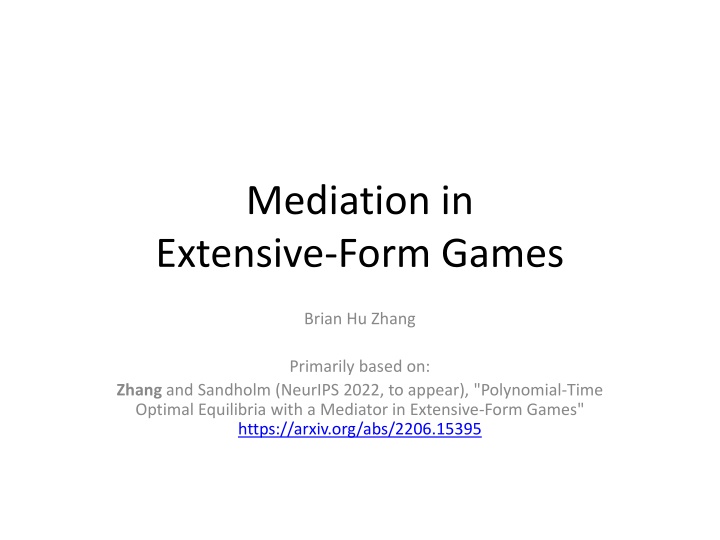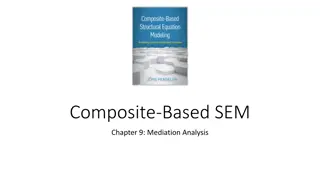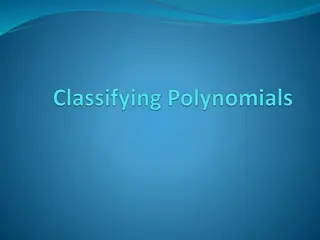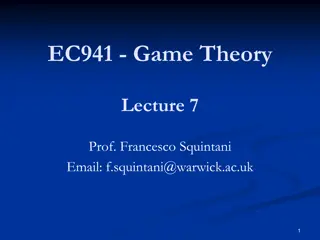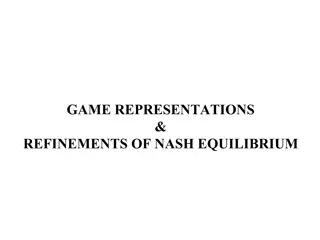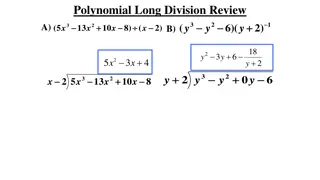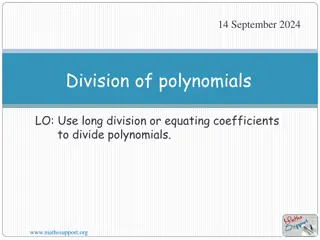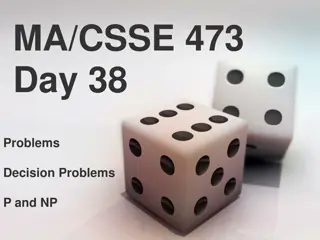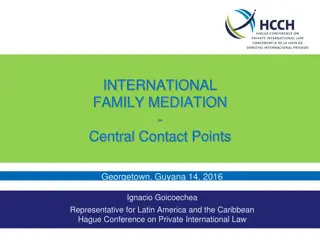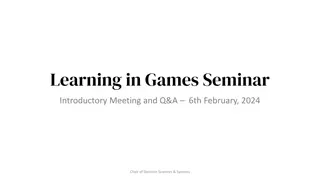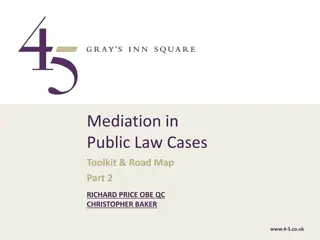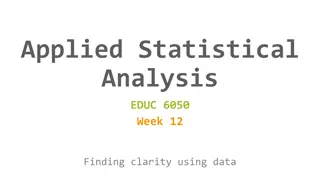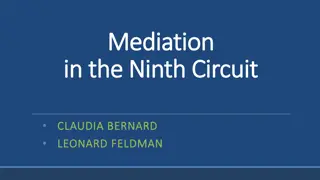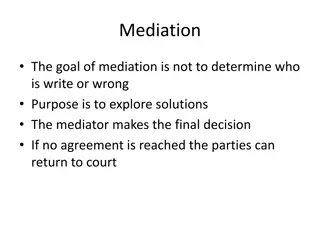Mediation in Extensive-Form Games: Polynomial-Time Optimal Equilibria
This content discusses the concept of mediation in extensive-form games based on the work of Zhang and Sandholm. It explores correlated equilibria in normal-form games and the role of a mediator in achieving Nash equilibrium among players. Various game scenarios, strategies, and equilibrium concepts are illustrated.
Download Presentation

Please find below an Image/Link to download the presentation.
The content on the website is provided AS IS for your information and personal use only. It may not be sold, licensed, or shared on other websites without obtaining consent from the author.If you encounter any issues during the download, it is possible that the publisher has removed the file from their server.
You are allowed to download the files provided on this website for personal or commercial use, subject to the condition that they are used lawfully. All files are the property of their respective owners.
The content on the website is provided AS IS for your information and personal use only. It may not be sold, licensed, or shared on other websites without obtaining consent from the author.
E N D
Presentation Transcript
Mediation in Extensive-Form Games Brian Hu Zhang Primarily based on: Zhang and Sandholm (NeurIPS 2022, to appear), "Polynomial-Time Optimal Equilibria with a Mediator in Extensive-Form Games" https://arxiv.org/abs/2206.15395
2 Warm-up: Correlated Equilibria in Normal-Form Games(via Extensive Form!) Chicken Dodge Straight 0, 0 20% -1, +1 40% Dodge +1, -1 40% -5, -5 0% Straight d s R R d s d s d s d s d s d s d s d s d s d s d s 0 0 0 0 - -1 1 +1 +1 0 0 0 0 - -1 1 +1 +1 +1 +1 - -1 1 - -5 5 - -5 5 +1 +1 - -1 1 - -5 5 - -5 5 0 0 0 0 - -1 1 +1 +1 0 0 0 0 - -1 1 +1 +1 +1 +1 - -1 1 - -5 5 - -5 5 +1 +1 - -1 1 - -5 5 - -5 5
3 Warm-up: Correlated Equilibria in Normal-Form Games Chicken To find a correlated equilibrium: find a strategy for the mediator such that, in the game among the players that results from holding the mediator's strategy fixed, the obedient strategy profile is a Nash equilibrium. Dodge 20% 40% (via Extensive Form!) Dodge Straight 0, 0 -1, +1 +1, -1 40% -5, -5 0% Straight d s R R d s d s obedient strategy profile d s d s d s d s d s d s d s d s d s 0 0 0 0 - -1 1 +1 +1 0 0 0 0 - -1 1 +1 +1 +1 +1 - -1 1 - -5 5 - -5 5 +1 +1 - -1 1 - -5 5 - -5 5 0 0 0 0 - -1 1 +1 +1 0 0 0 0 - -1 1 +1 +1 +1 +1 - -1 1 - -5 5 - -5 5 +1 +1 - -1 1 - -5 5 - -5 5
4 Warm-up: Correlated Equilibria in Normal-Form Games (via Extensive Form!) To find a correlated equilibrium: find a strategy for the mediator such that, in the game among the players that results from holding the mediator's strategy fixed, the obedient strategy profile is a Nash equilibrium. find mediator strategy ? such that for all players ? obeying is a best response to ? if all other players are also obedient
5 Warm-up: Correlated Equilibria in Normal-Form Games (via Extensive Form!) To find a correlated equilibrium: find a strategy for the mediator such that, in the game among the players that results from holding the mediator's strategy fixed, the obedient strategy profile is a Nash equilibrium. find mediator strategy ? such that for all players ? ?? ????(?,??,? ? ,? ? ) ??(?,?? ) max Bilinear function of ? and ?? Constants! Linear function of ? Notation: ??= ?? ? ????= ??: strategy space of player ? ?? ??: the payoff of player ? in the given strategy profile ??: the obedient strategy of player ?
6 Warm-up: Correlated Equilibria in Normal-Form Games (via Extensive Form!) To find a correlated equilibrium: find a strategy for the mediator such that, in the game among the players that results from holding the mediator's strategy fixed, the obedient strategy profile is a Nash equilibrium. find mediator strategy ? such that for all players ? ?? ????(?,??,? ? ? ,? ? ) ??(?,?? ?? ) ? ???? max Notation: ??= ?? ? ????= ??: strategy space of player ? ?? ??: the payoff of player ? in the given strategy profile ? ???? = ???,??,? ? ?? ??: the obedient strategy of player ? ? = ??(?,?? ,? ? )
7 Warm-up: Correlated Equilibria in Normal-Form Games(via Extensive Form!) To find a correlated equilibrium: find a strategy for the mediator such that, in the game among the players that results from holding the mediator's strategy fixed, the obedient strategy profile is a Nash equilibrium. Apply LP duality find mediator strategy ? find mediator strategy ? and dual multipliers ?? such that for all players ? ?? ?? such that for all players ? max ?? ? ???=?? ? ? ???? ?? ?, ?? ?? ?? ? ?? Notation: ??= ?? ? ????= ??: strategy space of player ? ?? ??: the payoff of player ? in the given strategy profile ? ???? = ???,??,? ? ?? ??: the obedient strategy of player ? ? = ??(?,?? ,? ? )
8 Warm-up: Correlated Equilibria in Normal-Form Games(via Extensive Form!) To find a correlated equilibrium: find a strategy for the mediator such that, in the game among the players that results from holding the mediator's strategy fixed, the obedient strategy profile is a Nash equilibrium. This is a linear program! Solve it with any LP solver ? ? find mediator strategy ? and dual multipliers ?? such that for all players ? ?? ?? max mediator strategy ? dual multipliers ?? arbitrary objective, for example, social welfare ?, ?? ?? ?? ? ?? Notation: ??= ?? ? ????= ??: strategy space of player ? ?? ??: the payoff of player ? in the given strategy profile ? ???? = ???,??,? ? ?? ??: the obedient strategy of player ? ? = ??(?,?? ,? ? )
9 Can we generalize this idea to other useful problems?
10 Idea: In an extensive-form game, add a mediator with the power to both send and receive messages from players. By varying exactly how the messaging system works, we will recover algorithms for all sorts of different problems that are seemingly unrelated
11 Communication Equilibria It's my turn! <some message> Mediator Ah, your message is helpful <some message> Ah, that's useful to me. Now I know what action I should pick Forges (Econometrica 1986), "An approach to communication equilibria"
12 Communication Equilibria It's my turn! What should these messages be? <some message> I still remember what the previous player sent me. Mediator <some message> <selects an action> A communication equilibrium is a mediator strategy ?, and a strategy profile (?1, ,??) for the players such that, with the mediator's strategy held fixed, (?1, ,??)is a Nash equilibrium for the players. Forges (Econometrica 1986), "An approach to communication equilibria"
13 The Revelation Principle Theorem [Revelation Principle]: For any "reasonably nice" notion of equilibrium with a mediator, the following assumptions can be made without loss of generality. 1. In equilibrium, players always send their true information to the mediator. The mediator's messages to the player are action recommendations. In equilibrium, players always obey action recommendations. 2. 3. without changing the space of possible equilibrium outcomes--in particular, without changing the optimal equilibrium under any objective
14 The Revelation Principle: Proof Sketch 1. In equilibrium, players always send their true information to the mediator. My current infoset is ? My current infoset is ? You would have sent ?(?). I'll pretend you did. Mediator Mediator ?(?) My current infoset is ? My current infoset is ? My current infoset is ? Mediator ?(? ) Mediator
15 The Revelation Principle: Proof Sketch 2. The mediator's messages to the player are action recommendations. 3. In equilibrium, the players always play the recommended actions. I would send message ?, which would cause you to play the action ? = ?(?) Mediator ? Mediator Okay, I'll play the action ?(?) You should play action ? OK! Mediator Mediator ? You should play action ? I'm going to play ? = ?(? ? ) No, I'm going to play action ? = ?(?) instead
16 The Revelation Principle: Commitment The revelation principle fundamentally relies on the ability of the mediator to commit to a strategy before the players decide what to do. ? = 1 Example game: Nature picks ? 0,1 uniformly at random and tells the player The player and mediator undergo one round of communication Player picks ? 0,1 Player gets utility 1 if and only if ? = ? (and 0 otherwise) Mediator gets utility 1 if and only if ? ? (and 0 otherwise) I'm going to obey the mediator Play ? = 0 Mediator
17 The Revelation Principle: Commitment The revelation principle fundamentally relies on the ability of the mediator to commit to a strategy before the players decide what to do. Mediator Example game: Nature picks ? 0,1 uniformly at random and tells the player The player and mediator undergo one round of communication Player picks ? 0,1 Player gets utility 1 if and only if ? = ? (and 0 otherwise) Mediator gets utility 1 if and only if ? ? (and 0 otherwise) I commit to always telling you to play ? = ? That sounds more reasonable. Now it makes sense for me to be honest and follow recommentations!
18 Polynomial-time Communication Equilibria Theorem [Zhang and Sandholm 2022]: Given an extensive- form game with ? nodes, an optimal communication equilibrium can be computed in time polynomial in ?. Proof Sketch 1. Consider the augmented extensive-form game in which the mediator is an explicit extra player, like we did for normal-form correlated equilibria. 2. Prove a slightly stronger version of the revelation principle that ensures that can be simplified to have size ?(?2) 3. Use the LP we already wrote down to compute an optimal strategy for the mediator in such that the player strategy profile in which every player reports information honestly and plays recommended actions is an equilibrium. Zhang and Sandholm (NeurIPS 2022), "Polynomial-Time Optimal Equilibria with a Mediator in Extensive-Form Games"
19 Lots of related useful problems! Optimal correlated equilibria in normal-form games Optimal mediated equilibrium Optimal Bayesian persuasion (information design) in extensive-form games Optimal automated mechanism design Optimal extensive-form correlated equilibria in extensive-form games
20 Lots of related useful problems! Optimal correlated equilibria in normal-form games Optimal mediated equilibrium Optimal Bayesian persuasion (information design) in extensive-form games Optimal automated mechanism design Optimal extensive-form correlated equilibria in extensive-form games
21 Mediated Equilibrium Prisoner's Dilemma find mediator strategy ? ?mediator such that for all players ? ?? Defect Cooperate is a best response to (?,? ? ) Defect 0, 0 2, -1 Cooperate -1, 2 1, 1 R use play mediator independently play use independently mediator R R d c d c d c d c d c d c d c d c d c d c d c d c 0 0 0 0 2 2 - -1 1 - -1 1 2 2 1 1 1 1 0 0 0 0 2 2 - -1 1 - -1 1 2 2 1 1 1 1 0 0 0 0 2 2 - -1 1 - -1 1 2 2 1 1 1 1 0 0 0 0 2 2 - -1 1 - -1 1 2 2 1 1 1 1
22 Lots of related useful problems! Optimal correlated equilibria in normal-form games Optimal mediated equilibrium Optimal Bayesian persuasion (information design) Optimal automated mechanism design Optimal extensive-form correlated equilibria in extensive-form games
23 Information Design ? players playing an extensive-form imperfect- information game The mediator hasan informational advantage over the players. In particular, the mediator always knows at least the infoset of the acting player, and has perfect recall. Therefore, the players don't need to send messages to the mediator because that would be pointless (the mediator knows the acting player's information already) Question: How should the mediator send signals so as to persuade the players to act in some desirable way? Revelation principle: WLOG, signals are action recommendations Kamenica and Gentzkow (American Economic Review 2011), "Bayesian Persuasion"
24 Information Design: An Example A seller ("mediator") wishes to persuade a buyer ("player") to purchase an item The item's quality is either low (p=3/4) or high (p=1/4). The seller knows the quality of the item, but the buyer does not. The seller scores 1 if the buyer buys the item. The seller can commit to a messaging scheme. The buyer can pass (P) or buy (B). The buyer wants to buy only high- quality items: she scores 1 if she buys a high-quality item and -1 if she buys a low-quality item The seller learns the quality of the item and sends a signal to the buyer Revelation principle: seller's signal is a recommendation High 1/4 Low 3/4 P B P B P B P B P B P B 0 0 0 0 1 1 1 1 0 0 0 0 - -1 1 1 1 0 0 0 0 1 1 1 1 0 0 0 0 - -1 1 1 1 Kamenica and Gentzkow (American Economic Review 2011), "Bayesian Persuasion"
25 Information Design: An Example The buyer learns the seller's message, but not the true item quality, and decides how to act A seller ("mediator") wishes to persuade a buyer ("player") to purchase an item The item's quality is either low (p=3/4) or high (p=1/4). The seller knows the quality of the item, but the buyer does not. The seller scores 1 if the buyer buys the item. The seller can commit to a messaging scheme. The buyer can pass (P) or buy (B). The buyer wants to buy only high- quality items: she scores 1 if she buys a high-quality item and -1 if she buys a low-quality item High 1/4 Low 3/4 P B P B P B P B P B P B 0 0 0 0 1 1 1 1 0 0 0 0 - -1 1 1 1 0 0 0 0 1 1 1 1 0 0 0 0 - -1 1 1 1 Kamenica and Gentzkow (American Economic Review 2011), "Bayesian Persuasion"
26 Information Design: An Example find mediator strategy ? ?mediator such that for all players ? ?? A seller ("mediator") wishes to persuade a buyer ("player") to purchase an item The item's quality is either low (p=3/4) or high (p=1/4). The seller knows the quality of the item, but the buyer does not. The seller scores 1 if the buyer buys the item. The seller can commit to a messaging scheme. The buyer can pass (P) or buy (B). The buyer wants to buy only high- quality items: she scores 1 if she buys a high-quality item and -1 if she buys a low-quality item is a best response to (?,? ? ) High 1/4 Low 3/4 1/3 2/3 P B P B P B P B P B P B 0 0 0 0 1 1 1 1 0 0 0 0 - -1 1 1 1 0 0 0 0 1 1 1 1 0 0 0 0 - -1 1 1 1 Kamenica and Gentzkow (American Economic Review 2011), "Bayesian Persuasion"
27 Information Design: An Example In the optimal signaling scheme, the seller gets the buyer to buy a low-quality item 1/3 of the time! A seller ("mediator") wishes to persuade a buyer ("player") to purchase an item The item's quality is either low (p=3/4) or high (p=1/4). The seller knows the quality of the item, but the buyer does not. The seller scores 1 if the buyer buys the item. The seller can commit to a messaging scheme. The buyer can pass (P) or buy (B). The buyer wants to buy only high- quality items: she scores 1 if she buys a high-quality item and -1 if she buys a low-quality item High 1/4 Low 3/4 1/3 2/3 P B P B P B P B P B P B 0 0 0 0 1 1 1 1 0 0 0 0 - -1 1 1 1 0 0 0 0 1 1 1 1 0 0 0 0 - -1 1 1 1 Kamenica and Gentzkow (American Economic Review 2011), "Bayesian Persuasion"
28 Lots of related useful problems! Optimal correlated equilibria in normal-form games Optimal mediated equilibrium Optimal Bayesian persuasion (information design) in extensive-form games Optimal automated mechanism design Optimal extensive-form correlated equilibria in extensive-form games
29 Mechanism Design ? players, with private information The mediator takes all actions in the game but doesn't have any information Therefore, the mediator relies on the players to provide information The players' and mediator's payoffs depend on the players' private information and the mediator's actions. Question: How should the mediator play? Revelation principle: WLOG, the mediator should play in such a way that all players are incentivized to report their information honestly
30 Mechanism Design: An Example Role reversal! A few minutes ago A seller ("player") wishes to persuade a buyer ("mediator") to purchase an item The item's quality is either low (p=3/4) or high (p=1/4). The seller knows the quality of the item, but the buyer does not. The seller scores 1 if the buyer buys the item. The seller can commit to a messaging scheme. The buyer can pass (P) or buy (B). The buyer wants to buy only high- quality items: she scores 1 if she buys a high-quality item and -1 if she buys a low-quality item A seller ("mediator") wishes to persuade a buyer ("player") to purchase an item
31 Mechanism Design: An Example Revelation principle: seller's signal is the true quality A seller ("player") wishes to persuade a buyer ("mediator") to purchase an item The item's quality is either low (p=3/4) or high (p=1/4). The seller knows the quality of the item, but the buyer does not. The seller scores 1 if the buyer buys the item. The seller can commit to a messaging scheme. The buyer can pass (P) or buy (B). The buyer wants to buy only high- quality items: she scores 1 if she buys a high-quality item and -1 if she buys a low-quality item find mediator strategy ? ?mediator such that for all players ? ?? is a best response to (?,? ? ) High 1/4 Low 3/4 L H L H P B P B P B P B We've recovered an algorithm equivalent to the (randomized) mechanism design algorithm of Conitzer and Sandholm (2002)! 0 0 0 0 1 1 1 1 0 0 0 0 1 1 - -1 1 0 0 0 0 1 1 1 1 0 0 0 0 1 1 - -1 1 Conitzer and Sandholm (UAI 2002), "Complexity of Mechanism Design"
32 What happened? Incentive design example Mechanism design example High 1/4 High 1/4 Low 3/4 Low 3/4 1/3 2/3 1/2 Seller EV 0 P B P B L H L H 0 Buyer EV 0 P B P B P B P B P B P B P B P B 0 0 0 0 1 1 1 1 0 0 0 0 - -1 1 1 1 0 0 0 0 1 1 1 1 0 0 0 0 - -1 1 1 1 0 0 0 0 1 1 1 1 0 0 0 0 1 1 - -1 1 0 0 0 0 1 1 1 1 0 0 0 0 1 1 - -1 1 Answer: It matters who has the commitment power the mediator enjoys a Stackelberg commitment advantage!
33 Lots of related useful problems! Optimal correlated equilibria in normal-form games Optimal mediated equilibrium Optimal Bayesian persuasion (information design) in extensive-form games Optimal automated mechanism design Optimal extensive-form correlated equilibria in extensive-form games
34 Extensive-Form Correlated Equilibria Imperfect-Recall Mediators Information design: ? players playing an extensive-form imperfect-information game The mediator hasan informational advantage over the players. In particular, the mediator always knows at least the infoset of the acting player (and perhaps more), and has perfect recall. Therefore, the players don't need to send messages to the mediator because that would be pointless (the mediator knows the acting player's information already) Question: How should the mediator give recommendations? Answer: As usual, build an augmented game and solve for an optimal incentive-compatible mediator strategy .
35 Extensive-Form Correlated Equilibria Imperfect-Recall Mediators Information design Extensive-Form Correlation: ? players playing an extensive-form imperfect-information game The mediator has an informational advantage over the players. In particular, the mediator always knows at least the infoset of the acting player (and perhaps no more), and has imperfect recall. Therefore, the players don't need to send messages to the mediator because that would be pointless (the mediator knows the acting player's information already) Question: How should the mediator give recommendations? Answer: As usual, build an augmented game and solve for an optimal incentive-compatible mediator strategy In other words, the mediator cannot leak information between players its recommendations can only depend on what the player already knows (and some shared randomness) Problem: How do we optimize over the decision space of the mediator when the mediator has imperfect recall?
36 Finding Optimal EFCEs In general, computing optimal strategies for a player with imperfect recall is NP- hard, and therefore so is computing an optimal EFCE, for the same reason[Chu and Halpern 2001] For EFCE, there is a fixed-parameter tractable representation of the decision space, with size ? ? + ??, where ? = branching factor ? = depth ? = "information complexity" of game "amount of private information that is not public" ? hides factors polynomial in the size of the game [Zhang, Farina, Celli, and Sandholm 2022] Therefore, optimal equilibria can be found by solving an LP of that size In two-player games with public chance actions, there is a polynomially-sized representation of the decision space [Farina and Sandholm 2020; Zhang, Farina, Celli, and Sandholm 2022] In any case, finding one EFCE is easy, by either an ellipsoid-based method[Huang and von Stengel 2008] or regret minimization[Farina, Celli, Marchesi, and Gatti 2020] Zhang, Farina, Celli, and Sandholm (EC 2022), "Optimal Correlated Equilibria in General-Sum Extensive-Form Games: Fixed-Parameter Algorithms, Hardness, and Two-Sided Column-Generation" Farina and Sandholm (NeurIPS 2020), " Polynomial-Time Computation of Optimal Correlated Equilibria in Two-Player Extensive-Form Games with Public Chance Moves and Beyond" Farina, Celli, Marchesi, and Gatti (NeurIPS 2020), "Simple Uncoupled No-Regret Learning Dynamics for Extensive-Form Correlated Equilibrium" Huang and von Stengel (WINE 2008), "Computing an extensive-form correlated equilibrium in polynomial time" Chu and Halpern (Int J Game Theory 2001), "On the NP-completeness of Finding an Optimal Strategy in Games with Common Payoffs"
37 Lots of related useful problems! Optimal correlated equilibria in normal-form games Optimal mediated equilibrium Optimal Bayesian persuasion (information design) in extensive-form games Optimal automated mechanism design Optimal extensive-form correlated equilibria in extensive-form games Takeaway 1: Several seemingly disparate problems can in fact be grouped under the same umbrella and solved using very similar techniques
38 Lots of related useful problems! Optimal correlated equilibria in normal-form games Optimal mediated equilibrium Optimal Bayesian persuasion (information design) in extensive-form games Optimal automated mechanism design Optimal extensive-form correlated equilibria in extensive-form games Takeaway 2: The hardness of optimal equilibrium computation, at least among these equilibrium concepts, is driven by the imperfect recall of the mediator
39 More Scenarios Certifiable messages [Forges and Koessler 2005] The messages that a player can send are a function of the player's current information. Thus, some messages are certifiable. For example, if a player can only send a certain message ? from one information set ?, then sending ? certifies that the player is at ?. Under the nested range condition [Green and Laffont 1977], the revelation principle holds, and therefore our algorithm runs in polytime [Zhang and Sandholm 2022] The nested range condition asserts that, if a player at infoset ? can send a message pretending to be at information set ? , then the player at ? must also be able to send every message that she would be able to send at ? . It is the condition that we need to ensure that the revelation principle holds! LP size for certification is basically linear (unlike LP size for communication, which is quadratic) because players have far fewer deviations! Special case: full-certification equilibria are equilibria in which, at any information set ?, the player's only options are to send ? or send a special "empty message" . That is, all information sent by the player is certifiable. Zhang and Sandholm (arXiv preprint 2022), "Polynomial-Time Optimal Equilibria with a Mediator in Extensive-Form Games" Forges and Koessler (J Math Econ 2005), "Communication equilibria with partially verifiable types" Green and Laffont (Econometrica 1977), "Characterization of satisfactory mechanisms for the revelation of preferences for public goods."
40 More Scenarios Coarse deviations Extensive-form coarseness: Players must decide whether to obey recommendations before seeing them. Normal-form coarseness: Players must decide, at the beginning of the game, whether to play the obedient strategy or to play a different strategy; in the latter case, the player does not communicate with the mediator at all. In the mechanism design and information design contexts, this is sometimes called "ex-ante incentive compatibility", as opposed to "ex-interim incentive compatibility" Coarseness can be applied to various equilibrium concepts, in particular to communication and certification [Zhang and Sandholm 2022], and to correlation [Farina, Bianchi, and Sandholm 2020] Zhang and Sandholm (arXiv preprint 2022), "Polynomial-Time Optimal Equilibria with a Mediator in Extensive-Form Games" Farina, Bianchi, and Sandholm (AAAI 2020), "Coarse correlation in extensive-form games"
41 More Scenarios Normal-form correlated equilibria?? In an extensive-form game , a normal-form correlated equilibrium is a correlated equilibrium of expressed in normal form. That is, it is an equilibrium where the players are told at the start of the game their whole strategy and then can decide whether or not to play it This does not fit into our framework of "one round of communication per action taken by the player" The complexity of finding one normal-form correlated equilibrium in an extensive-form game is an open problem
42 Optimal (full-)certification equilibria are very fast to compute since the LP has basically linear size Experiments
43 Optimal communication equilibria are much slower to compute since the LP has quadratic size Experiments
44 Which is faster between correlated equilibrium and communication equilibrium is game-dependent Experiments
45 Experiments: Payoff Spaces In the left game, the set of communication equilibrium payoffs is a single point so that point is also the unique Nash payoff!
46 Experiments: Payoff Spaces In the right game, communication equilibria can achieve all EFCE payoffs and more Therefore, EFCE and communication equilibria are in general incomparable
